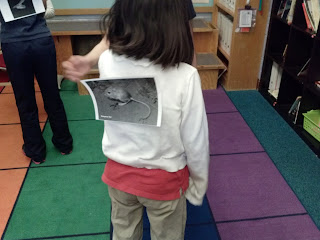Today we played one of my favorite games for reviewing concepts. And it just so happens that this game also gives me a lot of insight into my students' understanding. I don't remember the original name of the game, but I've played versions of it before at grown-up parties.
I've used this game for a lot of different topics. We've been studying environments and Utah animals lately, so today they each got a picture of a Utah animal taped to their back, where they couldn't see it. I've also used this for content terms and vocabulary. In 2nd grade, this was our weekly practice for our vocabulary words. After we had done our vocabulary routine to learn the words, I would give the kids 10 min. to study their words. They could jot down notes, draw pics of the words, quiz each other, whatever they wanted. It was always the most productive, focused time of the week and who would imagine 7-year-olds could study on their own?? This also gave me time to code a class set of index cards with the vocabulary words. I'd tape the words to their back, and they'd walk around trying to figure out which word was on their back. (After the first year, I had all the index cards laminated so I could use them year after year.)
Rules of the game:
1. Find out what's taped to your back by only asking yes or no questions
2. You can only ask one question per person, and you can only ask each person once
3. You only get once guess; if you're wrong you're out, if you're right, you can take it off your back and keep answering others' questions
4. There's only a given amount of time, so ask good quality questions!














